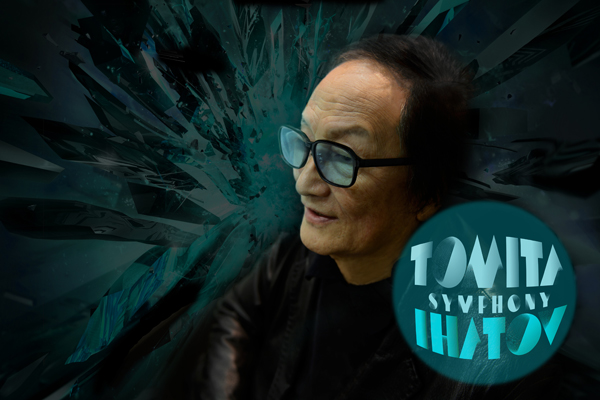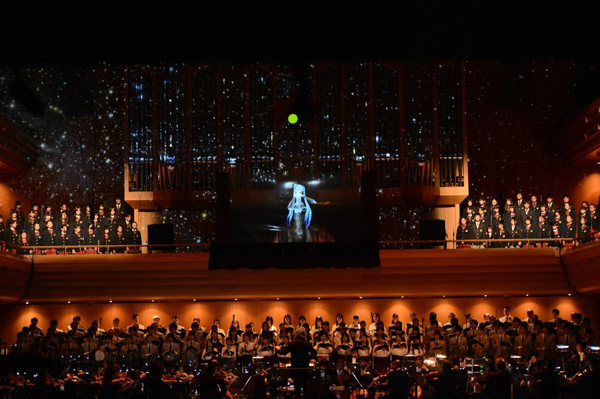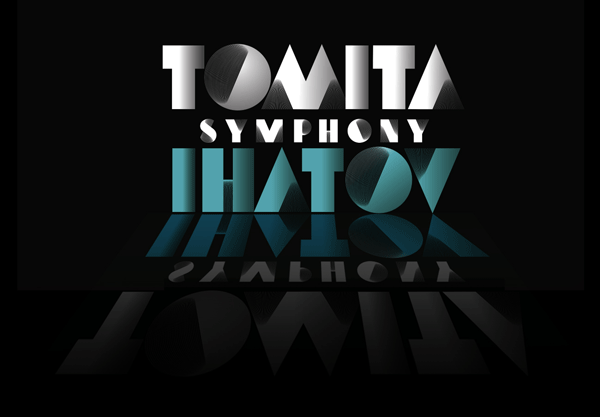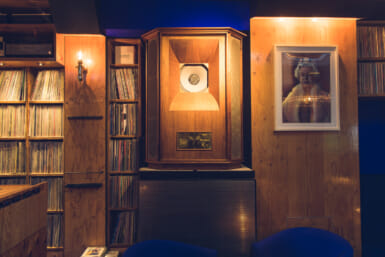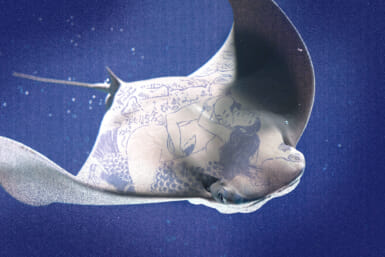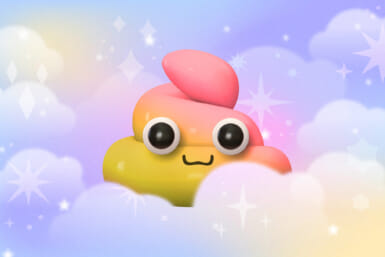On January 23rd, Nippon Columbia Records will release Isao Tomita’s Symphony Ihatov, World Premier Live Recording. The project features the smash sensation, vocaloid soloist Hatsune Miku, and will be released via iTunes to 41 countries.
Interview and text by Stack Jones. Translation by Joshua Brown and Michikazu Ichikawa
Many know Isao Tomita as the “father of Japanese electronic music” and his new magnum opus, Symphony Ihatov, debuted November 23rd at the Tokyo Opera City Concert Hall. The performance comprised appearances by Tomita himself, along with Hiroyuki Ito, the president of Crypton Future Media, the creators of Hatsune Miku, as well as Motokazu Shinoda, the synthesizer artist who conducted Miku in this technically spectacular achievement. The concert also included two choirs, and some of Japan’s finest musicians, courtesy of the Japan Philharmonic Orchestra. This musical masterpiece was conducted by none other than the world-renowned Naoto Ootomo.
As if that amount of talent wasn’t enough to guarantee an outstanding evening, the entire performance was also broadcast online, via Tower Records Japan’s new Live Stream Broadcast, which operates out of Shibuya. The virtual audience that tuned in for this event numbered more than 13,500.
Tomita’s Symphony Ihatov is based on the celebrated Japanese author Kenji Miyazawa’s euphoric children’s prose. Tomita, as a child, was greatly influenced by the works of Miyazawa. In the 1940s, Tomita turned inward, creating his own euphoric existence, which was the direct result of the world that surrounded him; a world permanently altered by the U.S. relentless air raids that decimated Tokyo, as well as Miyazawa’s hometown in Iwate.
Tomita, who spent his early childhood in China, questioned the harsh environment that surrounded him, as did Miyazawa. Ihatov is the name Miyazawa gave Iwate, in honor of his great devotion for the land of his birth. Likewise, Ihatov is the name Tomita gave to his latest symphony, in honor of Miyazawa’s work.
I first became familiar with Tomita’s synthetic rendition of DeBussy’s Arabesque No. 1 when I was just a child. The music was the theme to Jack Horkheimer’s Star Hustler, a hugely successful astrological TV show that was produced in my hometown of Miami, by the Miami Space Transit Planetarium. The show, which aired on PBS, was a mere five minutes in length, but it left the audience with an indelible memory that would forever credit Tomita as the creator of the modern age genre of space music.
Back in December, I was fortunate to have received an invitation to interview Tomita at Nippon Columbia Japan by Shotaro Kaizuka, who has worked on Tomita’s new release. Of course I jumped at the opportunity to interview Japan’s most celebrated musical genius.
Stack Jones: In April of this year, you turned 80. Yet, you just released this huge production, Symphony Ihatov. How long was this project in the works, and when did it first begin to take shape?
Isao Tomita: Actually, I won’t be into my eighties until next April. So, I’m still a very young man. As far as Symphony Ihatov, I began the orchestrations around May, and finalized the project in November.
What was the inspiration for the project?
Back in the 1940s I was reading books that were written by Miyazawa Kenji. I recall that they had great philosophical concepts that were easily understood by children. So, his work has always stayed with me.
You used the vocalist Hatsune Miku, which was created by Hiroyuki Ito, of Crypton Future Media. Miku is a hugely popular virtual vocalist. She gets millions and millions of views on YouTube. Simply amazing!
Yes, I had no idea that she was so popular. So, I was very pleased that she agreed to work with me.
[Everyone at the interview laughed at this statement.]
Seriously, how did this collaboration come about?
Miyazawa’s character was supposed to be a boy, but in reality it was a girl. A tomboy! A very boyish girl! So, in creating the symphony, I wanted a voice that could capture that part of Miyazawa’s character. When writing this symphony, I also felt that the human voice was incapable of capturing that sentiment.
What I’ve noticed listening to Miku’s voice is that she often projects sexuality, and is very powerful performance, yet in Symphony Ihatov, she’s much more fragile, and her voice, alien, yet more childlike.
One of the great qualities of Miku is that this character doesn’t have a defined personality. As a result, the end user has the ability to give her a variety of characteristics. That’s was one of the main reasons that I wanted to work with Miku’s creators. As a result of this attribute, Miku is open to a vast array of individualized interpretation.
Yes, her voice in Symphony Ihatov blended very naturally with the youthful choir that sang during the live performance.
[Tomita smiles, and nods in agreement.]
What audience was Symphony Ihatov intended for?
I didn’t have a particular audience in mind when I composed this music, or when I decided to work with Miku.
Did you create this symphony as a memorial to the disaster that took place in Tohoku where Iwate is located?
No, this project is based on Miyazawa’s literature. I did have the people of Iwate on my mind when I was working on it, but I didn’t create Symphony Ihatov to give Iwate courage, or to inspire them either. It’s up to the audience to feel as if they are inspired in that way or not. It’s up to the audience to decide for themselves.
When did you first commit yourself to creating music that would be attributed to Miyazawa’s work?
I first realized that I wanted to do something with Miyazawa’s literature about ten years ago. As you know, Miyazawa’s writing did not exist as music; it was just, kind of like a vague character that needed a medium of full expression. So, I decided to create a soloist that could turn his work into something much more tangible. Mostly, though, I wanted to create a character that would actually represent the sentiments of Miyazawa’s work in a musical form.
Well, you definitely accomplished that.
[laughs] Well, actually at the time, I didn’t know that Miku was so famous.
Until I began to research for this interview, I didn’t know that either. Let’s go back a little in time. On the website isaotomita.net, you credit Switched On Bach, by Wendy Carlos as the catalyst that drove you toward wanting to create synthesizer oriented music. What was the immediate impact on you when you heard Carlos’ work for the first time?
I liked the fact that music could be created with this new instrument, or machine. That there was now an endless ability to create sounds that had never been heard before, and without limit to shaping their tonality.
I was impressed with this new reality, that music could be interpreted with so much color, and this machine, which was called the Moog Synthesizer was the means to this end. Bach was a great composer to work with on this new medium. Bach’s music has many lines that blend together and there is so much room for creativity.
Snowflakes Are Dancing was released in 1974. You recorded this album in over a fourteen-month period, performing each note in individually, or in mono form, which was the only way a synthesizer could be played at that time.
This was well before we had polyphonic synthesizers. So, how difficult was it to be the engineer, the producer, the composer, arranger, and musician on this project? And to have such impeccable timing while layering all these tracks together?
I don’t make that distinction in my mind between the different roles in creating a final product. I feel it’s more like an artist that applies each of the colors to a painting until the final work is completed. It’s like when someone plays a traditional folk instrument, like the biwa, singing and playing, or performing both roles simultaneously, in addition to the other skills, such as composing, arranging, and the like.
Rick Wakeman’s synthesizer work on the Yes, And You and I album was one of the pieces of music that drew me into the world of synthesizers. You had the opportunity to work with Rick Wakeman on the Nagoya Sound Cloud Project. How were you introduced to Rick Wakeman, and how did you end up collaborating?
On the Sound Cloud Project, we didn’t actually play together. We performed individually, and then I brought the entire project together. The place that this event took place was shaped like a dome, and we placed many video screens around the dome.
I wanted it to look like a UFO, and that the video screens were the spaceship windows that looked out onto the universe that surrounded us. Rick’s contribution to the project was Mahler’s Symphony No. 2.
He actually played the piano on the piece. Alan Paul of Manhattan Transfer was one of the producers of the event. He has an amazing ability as a producer.
One of the ideas was that Manhattan Transfer was a rock band from outer space, and they would knock on the windows of the spaceship trying to get in, so they could perform as well.
[Some time after our interview Rick Wakeman responded to one of my emails: He says, “I had the great pleasure of working with Tomita in Japan some years ago and it was an absolute joy. The man is a tremendous musician with a unique style that is passionate, and one that he is dedicated to. On top of that he is a true gentleman.”]
When we think of Tomita, we think of you as the father of synth, space, and ambient music. This began in 1974 when Snowflakes Are Dancing, which was nominated for several Grammys.
When I was a child, Japan was closed to western music. This was during the second world war. At the end of the war, a lot of western music started to be broadcast on the radio. Jazz, pop songs, and classical music was filling the airwaves of Japan.
To me, that music sounded like it was coming from aliens in outer space. That was really what I thought. I thought I was listening to music from outer space. It was difficult to find your own identity at that time.
In 1969, a struggling British musician trying to find his own identity, named David Bowie released a single called, Space Oddity. This song was released at the time Neil Armstrong was making the first moonwalk. Elton John openly admits that his 1972 song, Rocket Man was a rip off of David Bowie’s successful tune. I’m curious if Bowie’s Space Oddity played an integral role in introducing you to space music?
Is that the song where an astronaut went into space and wasn’t able to return?
Yes. Was it this new pop genre, or would you credit Holst’s, Planets, composed between 1914, and 1916, as the inspiration that moved you into the direction of this new futuristic medium?
It was most definitely The Planets.
Holst’s daughter refused the release of your Planets. Why did she block the release of this work of yours?
Holst’s daughter was very rigid about how her father’s work was interpreted. She didn’t object to the synthesizers, she just didn’t want her father’s work rearranged differently from the way he had originally intended. So, it wasn’t the synthesizer that she didn’t like. She also objected to the way the piece was arranged for ballet performances.
Well, not so surprising your rendition of Holst’s, The Planets has become a collector’s item, and it’s extremely rare to find a copy. Yet, it’s very popular on video sites like YouTube. Ironically, your Planets is in high demand, and all comments regarding the album are extremely positive.
[Tomita didn’t know that his music is shared all over the world and that his music is posted on numerous websites.]
Your version of Mars, The Bringer Of Wars is led in with electronic voices that sound as if they were communicating in preparation for an attack. It really pulls the listener in. Then, suddenly those voices begin to sing in unison. At that point the audience doesn’t know what to expect. Then… the alarm and a countdown in alien voices, and then an explosion. It was surreal to hear for the first time. Simply genius.
I actually recorded those voices in a unique way. I recorded them onto a tape recorder, and then drove up to the 5th station of Mt. Fuji. I broadcasted the voices through a transceiver, and then recorded them as I drove down to the ocean. I learned later that there was a military base nearby. I was worried that I might have interfered with their broadcasting frequencies. Looks like I was OK though.
[laughter all round]
Do you plan to ever release your version of The Planets?
Actually, Columbia has rereleased The Planets with new horns parts. I was never happy with the original ones.
Switched On Bach was credited to Walter Carlos in March of 1968. Of course, Walter turned out to be Wendy who had worked with Robert Moog to create the first synth demonstration for his new product. That first Moog appeared on the cover of the album, which you credited on your website for introducing you to synth music. Your website says your first synthesizer was a Moog III synth. Do you recall that particular equipment?
I didn’t even know there is a Tomita website.
Do you recall your first synthesizer? The name?
The Moog was sold in modules, not as a single piece of equipment. So, the modules didn’t have any particular name as I recall. Plugging those different modules into the tower and creating different sounds was something that each musician had to do themselves. It was hard work, but you could also create your own unique sound and skill that way, it was a part of the creative process.
Today, most original analog equipment is extremely difficult to find, and if it is found, and in good working condition, extremely costly for the average musician.
In those days it was very expensive to obtain that equipment, as the rate of exchange was ¥366 to US$1 When the equipment was shipped to Japan, it couldn’t be categorized as music equipment, so it would often spend weeks held up in customs. I went into great debt to purchase those modules. I really don’t want to talk about that. But, rather, I’d like to say that one could purchase those various Moog modules in pieces, and combine them together. That’s what I did.
For years, artists and the industry pushed digital equipment and digital productions. At one time you abandoned the analog world in favor of this new medium as well. Do you find it ironic that all that classic equipment is finding its way back into production?
No. Because there are no limits to what sound can be created with that equipment.
Today, which medium do you prefer?
Most definitely the analog equipment, but today all of it is useless. None of the equipment that I had works any longer.
In your earlier years, did you feel restrained in creating as a result of expensive analog equipment that was generally out of the financial reach of an average musician? Also, how difficult did you find it to create single – mono notes in multi-chord structures?
That equipment was extremely difficult to use. For example, there were no presets back then, so when you created a sound, it was very difficult to go back and recreate it. As a result, you couldn’t make any errors in recording, because there would be no way to go back and get that same tone again. Recording was very troublesome as recording tracks, on top of each other, in multiple layers was extremely difficult. I had to master timing. I had to record in perfect time. That was extremely difficult.
Do you have any advice for people who create music today? Should they be using the analog equipment everyone is trying to find, or is the digital medium preferred?
I think it doesn’t really matter whether one has a collection of digital or analog equipment. What matters most is putting together sounds that people will enjoy hearing. I don’t think in terms of digital and analog, I think that digital music is really just a continuation, another extension of the analog music that came before it.
My favorite Tomita albums are: DeBussy’s pieces which created Snowflakes Are Dancing (1974); Mussorgsky, Pictures At An Exhibition (1975); Stravinsky, The Firebird Suite (1975); Holst, The Planets (1975); and Pachelbel’s Canon In D Major. Canon Of The Three Stars (1984) Incredibly, any of these albums could be released today, and still sound as if they were recently produced. This is an astonishing feat. There is a definite timeliness to the albums you have created.
[Tomita smiles]
[I asked the translators if there was anything they’d like to ask Tomita and Michikazu Ichikawa made the following statement, to which Tomita responded.]
Michikazu Ichikawa: Your work has received great praise from people worldwide. When The Planets, and Pictures At An Exhibition were released I was a university student. I’ve been listening to these albums for almost 40 years now. Much of your work is based on the classics, not Japanese music. But when we Japanese listen to your music, we feel something nostalgic and are impressed deeply, even though these are European pieces. What is the origin of your creative ability?
Tomita: When I was a child, it was during the war. I, like all Japanese had no information except that which was broadcasted by the national military. In order to receive bombing alert information, and where the U.S. had been targeting, we had to turn on the radio and listen during all hours of the night. On one occasion I recall hearing new sounds which were alien to me, and which I had never heard coming from the radio before. I think those sounds were from U.S., and allied aircraft carriers that were getting closer to the Japan islands. I was inspired by those sounds, and this was the catalyst that began the creative spirit within me.
During World War II, we Japanese had nothing and were poor, but we kept our rural culture and traditions and relationships alive. I spent my youth during that time being filled with that rural culture. So, both those foreign new sounds, and the rural Japanese culture was my origin, the beginning of me as a creator of music.
Many people credit you for introducing them to classical music; music they otherwise had no interest in. Does that make you feel you’ve accomplished something unique?
If that is true, then I do feel good about that.
What do you feel is your most significant work?
Holst’s, The Planets.
Is there anything you’d change if you could? Is their something different that you would have liked to have done creatively, or professionally?
I’m pleased that The Planets was recently re-released. This was a very difficult project, and now with the new horns, I’m pleased with the results.
Do you get more pleasure from your own work, or interpreting a classic?
I enjoy both, but The Planets is my favorite work.
What is your favorite piano, or synthesizer today?
I believe feelings, hearts, and emotions are important to creating music. Not the instruments, or the equipment.
What future projects do you have planned?
I’m continuing to work with Columbia on updating some of my albums and remixing them to 5.1 surround sound.
Is there a studio recording planned for Symphony Ihatov?
No, this is a live recording project.
How do you feel when you’re working on a musical project? Do you get emotional, do you find yourself laughing, at something you’ve discovered? Are you filled with other emotions? What emotion would you say best describes how you feel during the creative process?
There are errors in everything I have done. It’s frustrating. So, I do the best I can to cover those mistakes in the mix.
Is there any music, such as a musical that you recall, or that you really enjoyed?
When I first heard The Sound Of Music, I really thought it came from another planet. Today it’s hard to imagine, but it really seemed like it was music from another world. I like Pajama Game, and South Pacific, as well as The Sound Of Music.
One last thought… How would you like to be remembered?
[Tomita smiles, but there is no response.]
Visit http://columbia.jp/ihatov for more information on Tomita’s musical releases.
Top photo/graphic by Stack Jones

